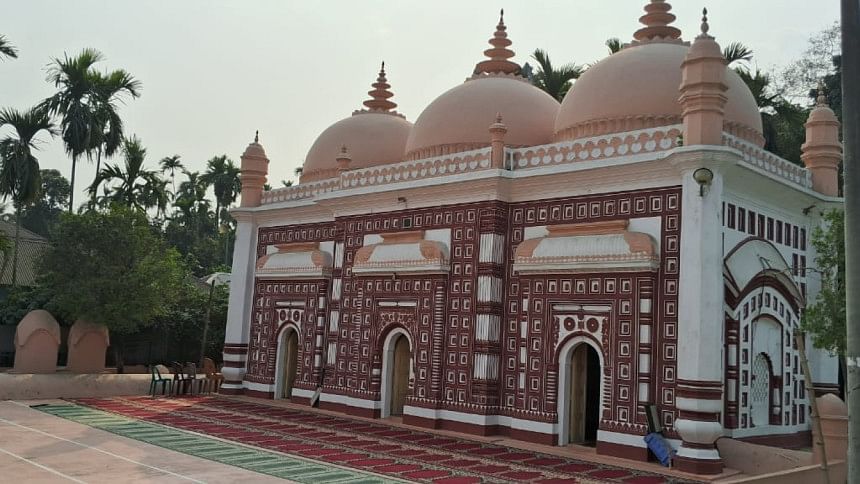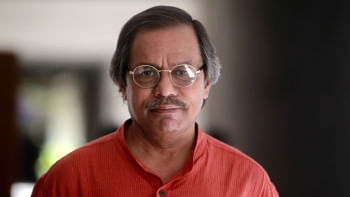Mirzapur Shahi Mosque: A testament to Mughal architecture

About 17 kilometres southwest from the town of Panchagarh, in a village called Mirzapur nestled cosily into Atwari upazila, an archaelogical relic from the Mughal era still stands. Some historians believe the Mirzapur Shahi Mosque to be 350 years old, and as a testament to the beauty of Mughal architecture, the historic structure remains a regular tourist attraction, drawing in visitors daily.
Built using lime and brick dust, the mosque features three arched entrances, adorned with intricate terracotta designs of floral and Islamic motifs.
The exact date of its construction and the identity of its architect remain the subject of historical debates.
However, experts unanimously agree that this mosque belongs to the Mughal era, as it bears distinct features of Mughal architecture.
Some archaeologists suggest that it was built during the reign of the Mughal ruler Shah Shuja.
A Persian inscription above the central doorway of the mosque provides further insight into its construction.
The inscription mentions two names – Rasul Mohammad Badr Sheikh Khan Baba and Sheikh Malek Uddin Akheruzzaman (or Akhtaruzzaman). Additionally, it bears the year 1206 of the solar calendar. When converted to the Hijri calendar and then to the Gregorian one, this corresponds to 1792 AD.
Based on the language and script of the inscription, some researchers assume that the mosque was completed during the rule of Mughal Emperor Shah Alam.
Local folklore, along with the inscription, suggest that a person named Sheikh Malek Uddin Akheruzzaman constructed the mosque, while the mention of the year 1206 indicates a later renovation.
According to the National Information Portal, the mosque's architectural style closely resembles that of the mosque located within the Dhaka High Court premises, which is believed to have been built around 1679. This has led historians to speculate that the Mirzapur Shahi Mosque was constructed around the same period.
The language and script of the inscription further suggest during the reign of Mughal Emperor Shah Alam, a man named Dost Mohammad oversaw the construction of this mosque.
Measuring 40 feet in length and 25 feet in width, the mosque also features three domes aligned in a single row, with a minaret at each of the four corners. The front has three entrances, with two small minarets flanking the main door and the central dome.
The interior walls are adorned with intricate carvings of flowers, vines, and calligraphy, beautifully decorated in various colours.
Built in the Mughal architectural style, the domes are connected at the top by a gradually narrowing belt. Four additional small minarets have been incorporated into the front and western walls.
In front of the mosque's main structure lies a rectangular paved courtyard with an open top. Outside, there is a beautifully designed arched gateway, showcasing remarkable craftsmanship. Additionally, in the mosque's north-eastern corner, there is an ancient well.
The gateway features a recessed arched entrance, fluted pillars on both sides, sloping eaves, and a moderately sized semi-circular dome.
On the south-eastern side of the mosque is the Imam Bara, also known as the Hoseni Dalan. The Imam Bara, made of bricks, has a circular interior with a single room. Several graves are seen adjacent to the mosque and the Imam Bara.
Mirza Nurul Islam Helal, vice-president of the mosque management committee, said although the archaeology department officially oversees the mosque, its operations are managed by a 21-member committee.
The mosque has around 28 bighas of cultivable land including a pond. The income generated from leasing these lands and pond is used to cover various expenses, including renovation and the salaries of the imam and the muezzin.
Mirza Ahmed Sharif, president of the Mirzapur Shahi Mosque Management Committee, said that in the 1990s, Mirza Gholam Hafiz, a former speaker and a native of Mirzapur, took steps to renovate the mosque under government supervision. During this period, the mosque was handed over to the Department of Archaeology.
However, the department has not provided much oversight of the mosque. Currently, it is managed by the local committee.
When three domes and the inner walls of the mosque were damaged in an earthquake in 2011, masons from Naogaon were brought in the following year to repair it, Sharif said.
The renovation and proper supervision of this historic mosque, which stands as a testament to our heritage, must be handled by the Department of Archaeology going forward, Sharif said.

 For all latest news, follow The Daily Star's Google News channel.
For all latest news, follow The Daily Star's Google News channel. 



Comments